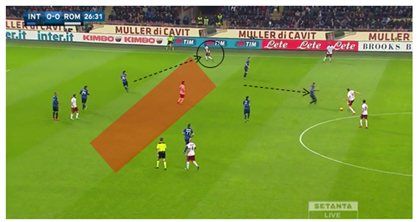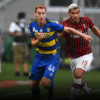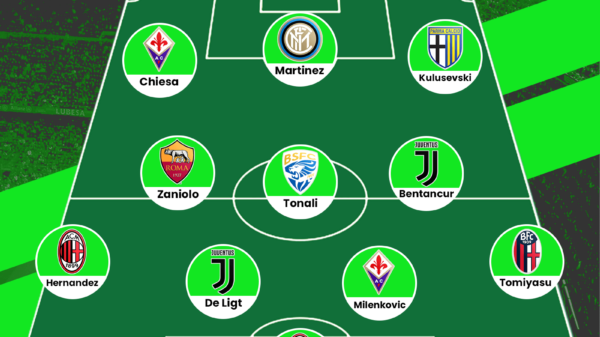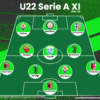With Juventus currently in the doldrums, the race for the Serie A is wide open. Fiorentina and Napoli are competing, and everyone expects Juventus to bounce back, but two sides that are being taken very seriously are Inter and Roma. The two met this past weekend in a typically tense fixture.
The league’s best attack squared up against the league’s best defence at the San Siro in what was sure to be an intriguing encounter from a tactical perspective. Rudi Garcia’s men came into this clash in fine fettle and were many people’s favourites to win the game having been top of the table, scoring 25 goals in the process. However, it was Roberto Mancini’s Inter who came out victorious after a defensive masterclass; Roma were kept at arm’s length throughout the contest with Inter suffocating the centre and Roma being inept in the final third for much of the game. They struggled to create chances due to poor decision making and an abject performance from frontman Edin Dzeko, who in my mind was largely responsible for Roma’s ineffectiveness in the final third as they had to attack in a way that suited his skill set. Their misery was compounded in the 73rd minute when playmaker Miralem Pjanic received his marching orders after a second yellow card, dashing any hopes they had of staging a late comeback.
INTER 1-0 ROMA
Line Ups:
Inter (4-3-3/4-1-4-1): 1. Handanovic // 33. D’Ambrosio, 25. Miranda, 24. Murillo, 55. Nagotomo // 17. Medel, 77. Brozovic, 13. Guarin // 44. Perisic, 10. Jovetic, 22. Ljajic
Roma (4-3-3): 25. Szczesny // Maicon, 44. Manolas, 2. Rudiger, 3. Digne // 4. Nainggolan, 15. Pjanic, 24. Florensi // 11. Salah, 9. Dzeko, 27. Gervinho
Substitutions: 51’ Kondogbia (Medel), 65’ Palacio (Jovetic), 79’ Ranocchia (D’Ambrosio) // 64’ Iago Falque (Florenzi), 77’ Vainqueur (Dzeko), 84’ Iturbe (Gervinho)
Inter’s stubborn defensive block denies Roma access to centre
After watching this performance it was not surprising to see why Inter have the best defensive record in Italy. They set up in a stubborn 4-1-4-1 block with a man-oriented zonal marking system, with the two 8s Brozovic and Guarin pressing Roma’s central midfielders when they entered the half-spaces with the ball. Gary Medel was largely responsible for limiting the space between the midfield and defensive lines, occasionally tracking runners who attempted to receive the ball in the 6 space and bring the ball into the final third.
In the image above is Inter’s shape in the defensive phase. In this image they have set up in a medium block to maintain the distance between Roma and their goal. Medel is in the space between the defence and midfield, playing the anchor role; he is keeping a close eye on Miralem Pjanic who has entered his zone. He has maintained his position in relation to the team set up but still made sure that he has access to Pjanic should he receive the ball. The two CMs were responsible for their opposite numbers; Guarin is acting similarly to Medel, he is still within the shape but is ready to apply pressure to Florensi while Brozovic is blocking the passing lane to Miralem Pjanic.
It must be considered though, that the two wide men, Perisic and Ljajic are key to this system as without them the central midfielders cannot maintain the team’s compactness in the centre. Both are in line with the midfielders despite on paper appearing to playing as wide forwards. Instead of defending as part of a front three and pressing high up field while the midfielders cover the wide areas and half-spaces, they drop deep and decide to cover those zones, allowing Inter to gain numerical superiority in the centre. As a result Inter suffocate the centre and force Roma to attempt to create in the wide areas.
This did, however have a detrimental effect on Inter’s attacking transitions as they were unable to counter-attack in the wide areas due to the extremely deep positioning of their wide players. Had they been further up the pitch they may have been able to manipulate the spaces left vacant by the Roma full backs when they pushed forward.
Inter aim to attack through middle, Roma focused on wide orientation
With Inter congesting the central areas and a target man in Edin Dzeko up front, Roma were left with no choice but to attack from the wide areas. Often times, Pjanic or Florensi would migrate to the wide area or half-space and attempt to combine with the full-back and winger. However the moves would often break down as they looked to finish the move with a cross into Dzeko, which proved futile as Inter had numerical superiority in the box. Being the most creative players in the team, Rudi Garcia’s men were heavily reliant on their wingers, Gervinho and Salah to create chances and disorganise the Inter back 4. They could be seen hugging the touchline, aiming to isolate their full-back and open up half-spaces for the central players.
Gervinho is out wide on the right which creates a problem for Nagotomo, the Inter full-back. If he decides to put pressure on Gervinho then the half-space opens up for Mohamed Salah (red zone), who can create numerical equality against the Inter centre backs with Pjanic. If he decides to maintain the defensive overload and not put pressure on Gervinho, then he has space and time to run at him. Although they did create a number of chances, barely any were clear cut. For most of the game they failed to disorganise the Inter defence, it was rare that they would circulate the ball and wait for gaps to appear. Had their structure in possession of the ball been better they have been in a better position to circulate possession and open up the centre and half-spaces to be exploited. For too long they failed to take advantage of these zones and were too frantic with their approach in the final third, choosing to cross aimlessly instead of using swift combinations and ball circulation to unsettle Inter’s block.
One solution to exploit the centre and improve their positional structure would be to push the full-backs forward to create width while the wingers occupied the half-spaces and their 8s remained in the centre.
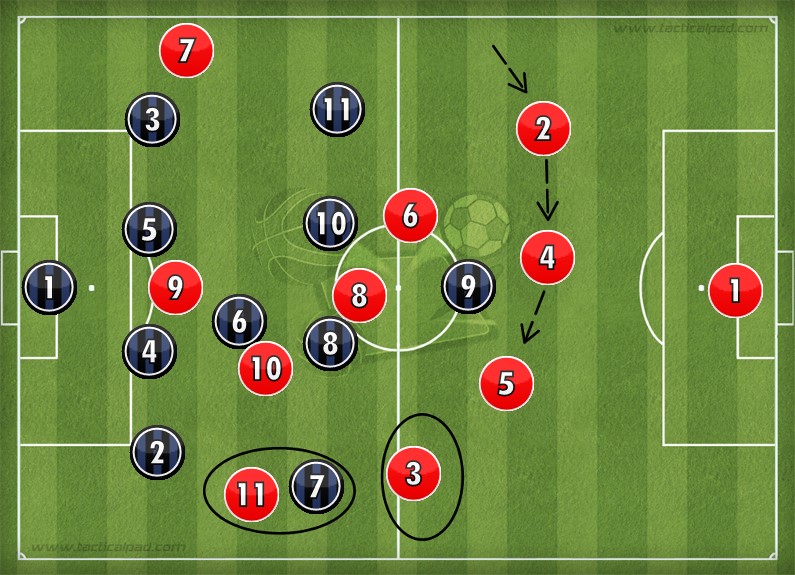
Example of how Roma could have set up in attacking phase
In the image above, Nainggolan is in possession and Inter are passive in their pressing although they did initiate pressing when one of Roma’s 8s received the ball in the half-space. Digne at left-back makes a run forward to distract the attentions of Perisic, as a consequence, Pjanic (red circle) now has an infinite amount of time to pick out a pass or run at the Inter midfielders. If Pjanic decides to drive forward with the ball he can attract Perisic and Brozovic towards him giving them space which they can exploit. If Perisic does press then Digne now has space out wide and can be found with a simple wall pass. Medel may decide to follow Gervinho in the half-space which creates space in the centre for Dzeko should he decide to drop off. This is all made possible by Digne’s decision to occupy a higher position up the field. His foray up front has been compensated for also by Maicon shifting across to create balance. Furthermore, Inter were quite ineffective in their attacking transitions anyway, something which Roma could have taken advantage of.
There were times when they were in a position to attempt combinations in the final third and break into the centre but for some reason, they would opt to go wide and cross instead, gifting possession away.
Roma are set up perfectly in this scene with all the correct spaces being occupied. They are positioned in triangles which make for more effective combinations and Pjanic has acres in the right half-space. Right-back Maicon is in possession having just received the ball from Gervinho; however his field of view is restricted as his body position only allows him to see Gervinho as a result he is unable to see Salah in space in the centre or even Florensi right in front of him. Instead of playing in Florensi or Salah he plays it back to Gervinho who puts it in the box and Inter head clear. This is just another example of how the numerical superiority created by the full-back can be manipulated.
Another ploy by Roma was to penetrate Inter’s back line with their wide men and Edin Dzeko, who often dropped off to drag the opposition centre backs with him in order to create space for Gervinho and Salah to make diagonal runs.
When this did occur, Pjanic would look to play the ball in behind, being the main orchestrator of play in this Roma side. However, as space between the lines condensed this tactic became less and less effective and Dzeko was soon frozen out of the game. It was after this happened that Roma began swinging cross after cross. Inter’s pressing became more co-ordinated thus denying Dzeko space to drop into.
Having decided upon exploiting the wide areas, Gervinho and Salah were often found on each other’s wings looking to create overloads. It worked and did create some confusion in the Inter defensive block as the full-backs were certainly not going to track their opposition winger to the other side of the field.
Gervinho (circled) has roamed to the right and Roma now have a 4v3 in this area. Should Gervinho receive the ball he can hold it up and attract pressure from Nagotomo, giving Florensi time and space to pick out a cross for Dzeko. Inter were quick to react to this and would often shift across as a unit to prevent the overload.
The build-up phase was often an issue for Roma too. Despite Radja Nainggolan being an excellent holding midfielder his ball-playing ability leaves a lot to be desired. That is not to say he is not a great passer of the ball, 87% pass completion is an impressive stat; however it was his decision making which was the issue. A lot of the time he would have to push forward while Pjanic and/or Florensi fill his space and take on his role momentarily. They would be the ones to circulate the ball and bring it into the next phase of the attack, Pjanic especially, who would occasionally be even deeper than the centre-backs. But being occupied with ball circulation in deeper areas meant that they were unable to have an effect on the game in the final third. It was because of this, as well as their poor structure in possession and Inter’s compactness that they were unable to really dominate the centre.
When looking closely at the diagram, we can see that despite completing a large number of his passes, he is still hindering his team because of the type of pass he is playing. Many of them are speculative long balls, which normally a player in his role does not usually play as in possession his job is to help circulate the ball and keep play ticking by playing short simple passes to the more creative players in the team. By constantly playing long balls he does not allow his team to have stable possession as they are not being given time to prepare themselves structurally.
Pjanic and Florensi drop deeper than Nainggolan and in this phase are operating as two 6s. This has a negative effect in an attacking sense as they are unable to occupying positions further forward and link the midfield and attack centrally. Had Roma had an anchor man who was comfortable in possession, one of their two 8s could have possibly occupied the right half-space.
One would have thought that Daniele de Rossi would have started this game instead as he is a much more intelligent ball player than Nainggolan. It is not as if Nainggolan’s defensive prowess was a necessity in this game as Inter rarely threatened in the 10 space, where he was occupying. Having de Rossi on the field would have allowed Pjanic and Florensi more freedom as they would not have had to pick up the ball from deep positions so often.
There were stark contrasts between Inter’s attacking set-up and Roma’s; from the off Mancini’s men were intent on controlling the centre in all phases of the game, including the attacking phase. They used Nagotomo as the sole provider of width, who did put in a cross or two but was used primarily to draw players out wide toward him and create space in the centre and half-spaces. When there was no opening they were willing to keep possession and wait for Roma to make a mistake. Their structure was compact and was such that it allowed for greater options for central combinations due to the number of players they had in that zone.
In this image Inter are set up similarly to how Roma were in the previous image, in fact it could be argued that Roma’s positioning was slightly better. The difference between the two sides was that one was aiming to gain superiority in the centre and the other was not. Nagotomo, out wide, began with the ball and lays it off to Ljajic. Instead of reverting to a wide position like Maicon did previously, he moved the ball back into the centre and attracted two Roma players towards him which freed up space for the Inter players centrally. After circulating the ball for a brief period, the ball is laid off to Medel who rifles it into the net. Even when looking at the chances Inter created in the game, it is clear to see their central orientation.
Where does this leave them?
After snatching a victory over the team considered favourites to steal Juventus’ crown as top dogs in Italy, Inter Milan have every right to believe that they can challenge for the title this season. However, 11 goals in 11 games is not a goal-scoring record which suggests they could be title winners but their sturdy defence could get them over the line come May. The Nerazzuri do have a talented squad but in my opinion, qualifying for the Champions League is a more realistic aim after their spectacular fall from grace in the last few years.
Despite losing this game and their grip on first place, Roma have no reason to be disheartened after playing some fantastic football in the first 10 games of the season. Rudi Garcia and his team will be desperate to finish top of the tree having been runners-up for the past two seasons. Juve’s abysmal form will be another reason to be optimistic as the men from the capital have a golden opportunity to put daylight between them and last season’s champions.
Written by Miles Olusina
- Scout Report: Marcus Thuram | Gladbach’s attacking sensation - July 17, 2020
- Tactical Philosophy: Paulo Fonseca - May 28, 2020
- Maurizio Sarri at Chelsea: Tactical Approach & Key Players - September 5, 2018





















































